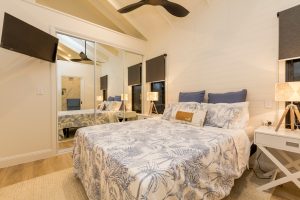 According to the Pew Research Center, the U.S. population living in multigenerational households has quadrupled since the 1970s. They also report that, in March of 2021, “there were 59.7 million U.S. residents who lived with multiple generations under one roof.”
According to the Pew Research Center, the U.S. population living in multigenerational households has quadrupled since the 1970s. They also report that, in March of 2021, “there were 59.7 million U.S. residents who lived with multiple generations under one roof.”
One of the most common multigenerational living scenarios is the addition of an in-law suite to accommodate an older person moving in with their grown children and grandchildren. If this arrangement is something you are thinking about, there is some appeal:
- Having an aging parent close at hand could reduce your burden by being able to quickly address their needs.
- Combining households would most likely lower living costs for your parents, so their money could be used for care that may be needed later.
- The need for expensive long-term care in a nursing home or other facility could be delayed.
But this isn’t a decision to make lightly.
To begin with, there are a lot of emotional considerations. Cohabitating can be trying under the best circumstances, and combining adult children and parents in the same household can, unsurprisingly, fall short of what you might consider the best-case scenario. For that reason, it’s critically important to plan ahead, have honest conversations about expectations, and put everything in writing.
But, there’s more to setting up a successful multigenerational household than working through relationship dynamics. Beyond sorting out how you will define tenancy and manage finances, there are a lot of tactical details to handle. It’s a good idea to take time and assess the in-law suite location, layout, design, and individual features.
Rules and Regulations
Before you can even think about creating a new living space in or adjacent to your home, you will need to research things like city and municipal zoning ordinances, local planning and subdivision regulations, permitting requirements, and property setbacks. What is allowable can vary greatly from town to town and within each neighborhood. There can be exceptions for expansions that accommodate family members, making it critical to do your due diligence.
Location — Location — Location
As in all things real estate, location is always the key concern. There are different ways to incorporate an in-law apartment or suite into an existing home. The trick is creating a space that will best suit your family’s needs.
- You can convert a little-used space in the home, like a formal dining or sitting room.
- Garage, porch, and basement spaces can be transformed into comfortable living spaces.
- You might consider a traditional addition that expands on an existing space.
- You might opt to build an accessory dwelling unit (ADU)—sometimes called a “granny flat”—which is basically a small outbuilding that is equipped with electricity and plumbing. (Think she-shed or man cave or tiny house.)
When brainstorming the best option for your in-law suite, keep privacy top of mind—both for your in-law, yourself and the rest of your family. Consider this: Do you want to share common areas like living spaces and the kitchen? Should the in-law space have its own entrance? Would a detached space be better than one that’s in the main house?
 Design Tips
Design Tips
As with any renovation or home-building project, it’s smart to take the time to consider design options in the planning stage, rather than trying to incorporate features later on. Here are a few of the design elements to keep in mind for in-law spaces:
- Privacy — We’ve already mentioned the importance of privacy for all parties, but it’s worth mentioning again. If a separate entrance is possible, that’s usually a good idea. And, again, think hard about if there will be shared spaces—not only for your current situation, but for other possible uses of the space (such as house guests or renters).
- First-floor Living — Many older people prefer housing that is on the first floor, and limited to one level. This means there are no stairs to navigate, which can be more difficult as we get older.
- Storage — While most people moving in with family are already thinking about downsizing, they will still likely appreciate a good amount of storage. It’s not easy to condense an entire life down, especially if the person has been living in their own home.
- Utilities —It won’t always make sense to have separate water and electrical, but it’s almost always a good idea to install separate phone, internet, and cable lines. You might also consider having independent head and A/C controls.
- Washer/Dryer — It may seem easier to just have your in-law use your washer and dryer, but—again—this can create privacy issues that would be better avoided. There are many stackable washer/dryer options on the market that are designed for smaller spaces, and perfect for in-law suites.
- Accessibility & Safety — As Bette Davis is rumored to have said, “Old age ain’t for sissies.” Aging comes with plenty of challenges. In-law spaces should include design features that make things as comfortable, safe, and convenient as possible. When designing your space, think about things like no-slip flooring, emergency call buttons, easy-open doorknobs and other hardware, grab bars and handrails, easy-to-reach storage, and so forth. And don’t forget smoke, fire, and carbon monoxide detectors. These small details can make a big difference in a person’s day-to-day comfort, confidence, and peace of mind.
Budget
Ultimately, many of your decisions will be driven by your budget. Different types of solutions — additions, freestanding units, in-home suites — will come with different price tags. And specific features and amenities will also make a big difference to the overall costs. Adding a full kitchen, for example, can be an especially pricey option since it involves not only additional space, but also the expense of a full set of appliances. One thing to keep in mind when considering the investment is how it compares to the potential cost of a retirement home, nursing home, or other long-term care facility. In addition, an in-law suite usually adds value to a home since it can be used as originally intended, or as an office space, a rental space (such as through Airbnb or VRBO), or a guest suite for visiting friends and family.
Big Decisions Take Time
Choosing to invite a family member to move in is a big deal. And renovating or adding on to your home to create an in-law suite or apartment is also a big decision that involves a lot of moving parts. Take your time and consider all of your options before bringing mom or dad into your space.
If you’re considering building your own in-law suite, don’t forget to check out our overview of legal considerations that will help ensure a successful multigenerational household.
Related Posts:
Are You Ready to Become Your Parent’s Primary Caregiver?
33 Resources to Help Caregivers
Being a Healthcare Advocate: 9 Important Tips
 Connecticut Estate Planning Attorneys Blog
Connecticut Estate Planning Attorneys Blog


